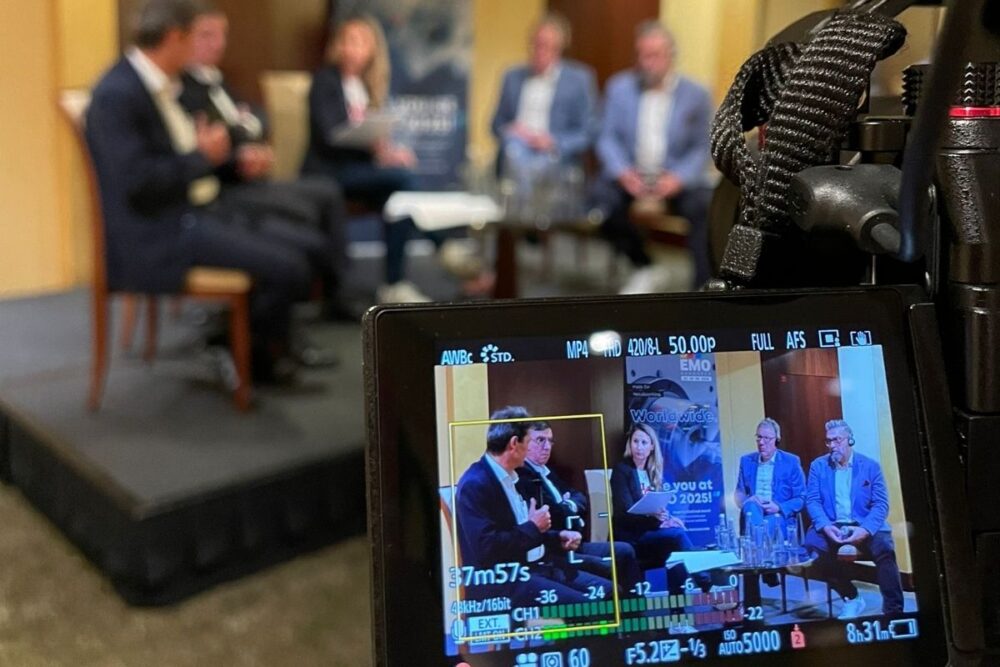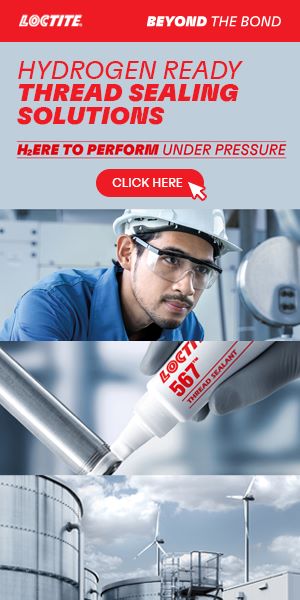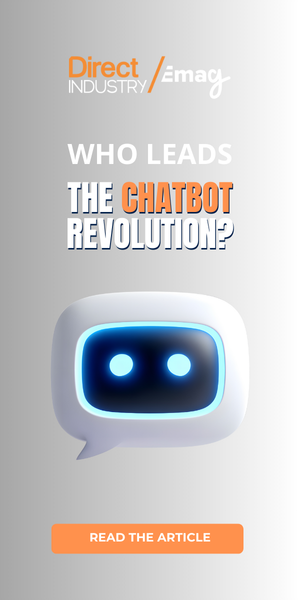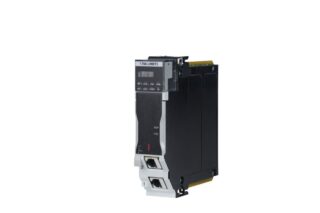The EMO Hannover 2025, a global benchmark for machine tools and production technologies, returns to Hannover from September 22 to 26, 2025, under the theme “Innovate Manufacturing”. This 50th anniversary edition comes at a critical time for European industry, which faces major challenges: competitiveness, energy transition, technological sovereignty, automation, and resilience. Our editor-in-chief, Camille Rustici, recently moderated a roundtable in Paris as part of the EMO World Tour, a global series of events in major capitals to explore the key themes of the upcoming show. Here’s what you need to know.
Watch the Replay
Last week, the Paris roundtable brought together leading voices in the sector to assess the current state of machine tool manufacturing and what visitors can expect from EMO 2025.
- Markus Heering, Managing Director of VDW, the German Machine Tool Builders’ Association;
- Hartwig von Saß, representative of Deutsche Messe, organizer of the EMO trade fair;
- Marc Troia, CEO of the French machine tool manufacturer Huron whose company will be exhibiting at EMO.
- Thierry Bouchaud, Head of the Motion Control Business Unit at Siemens France. He will be attending the trade fair as a visitor and as an exhibitor..
They examined the value of attending an industrial trade fair, the insights you can gain. They also shared tips on how to attract visitors to your booth and how to prepare effectively.
50 Years of Industrial Evolution
The 2025 edition of EMO Hannover marks a strategic milestone. The first EMO was held 50 years ago, on June 17, 1975, in Paris, drawing 1,300 exhibitors from 24 countries. Since 1977, Hannover has hosted the show alternately with Milan.
In 2023, the previous edition of the event in Hannover welcomed 1,800 exhibitors from 45 countries and 92,000 visitors, underscoring its global significance.
The Four Key Megatrends at EMO 2025
Under the theme “Innovate Manufacturing”, EMO Hannover 2025 will spotlight four industry-defining megatrends:
1. Automation
With a shortage of skilled labor across Europe, automation and robotics are vital for productivity and competitiveness.
“Machining is shifting from pure machine tool use to robot-driven processes—with all the benefits that brings,” says Thierry Bouchaud, Head of the Motion Control Business Unit at Siemens France
2. Sustainability
Reducing environmental impact is now a strategic imperative.
“Resources are finite. We see the planet changing and we must act responsibly,” says Markus Heering, Managing Director of VDW, the German Machine Tool Builders’ Association.
For energy-intensive sectors like mechanical engineering, this means more energy-efficient machine tools and sustainable production.
3. Digitalization & AI
Artificial intelligence is transforming manufacturing. Real-time data enables predictive maintenance, process optimization, and hyper-personalized production.
“Edge computing is about collecting data directly from the machine — and then we can prevent collisions on the machines. And when you consider how expensive it is to repair a spindle after a collision, it’s absolutely critical,” explains Bouchaud.
4. Additive Manufacturing
Once limited to prototyping, metal 3D printing now supports full-scale production. EMO 2025 will feature a dedicated area for this game-changing technology—now ready to meet the demands of aerospace, defense, and energy sectors.
READ ALSO
Tech Challenges Demand Real-World Solutions
Attending a trade fair provides the opportunity to find solutions. According to Markus Heering, from VDW:
“Technologies are evolving, and customers must constantly update their production technologies.”
This is particularly relevant in the field of modern machining, where new materials and advanced processes are reshaping manufacturing. And that’s exactly where exhibitors come in — to provide answers and demonstrate innovations. As Thierry Bouchaud from Siemens explains:
“At our booth, we will demonstrate how machines are connected, how we collect data from them, and how this data delivers real value. This is the dynamic we want to create: a space where our customers can find clear answers to the solutions they’re seeking.”
For Hartwig von Saß, from Deutsche Messe, the trade fair organizer, the unexpected is also part of the EMO experience. It’s not just about validating an already-made decision or buying a machine that has already been sourced, but also about being surprised, questioning certainties, and sometimes… making a completely unexpected strategic shift. These unplanned but pivotal experiences are at the heart of innovation. He calls this serendipity:
“Even if it may sound a bit philosophical, these moments are crucial to advancing innovation. Innovations rarely emerge from a single flash of genius. It’s an important strategic process. And attending trade fairs — especially EMO — can significantly accelerate this process.”
He cites a German business leader who, at EMO 2019, bought a new machine unexpectedly — without knowing beforehand he would need one — and ended up equipping his factory with it.
His recommendation to trade fair visitors:
“Preparing for a trade show visit in such a way that about half of the available time is dedicated to scheduled meetings with companies — to engage in business discussions, ask specific questions, and get clear answers.”
The other half, he says, should be spent freely walking through the halls, seeking inspiration and picking up on “weak signals.”

In Search of Weak Signals
But what are weak signals? While EMO is universally recognized as the world’s leading trade fair for production technologies, its value goes far beyond the discovery of new machines and innovations. What many industry professionals seek—beyond technical demonstrations—are the weak signals that Hartwig von Saß referred to: subtle, sometimes unexpected clues that reveal underlying industry trends, drive progress and innovation, and may uncover opportunities to enhance their own production processes.
That’s precisely what Marc Troia, CEO of French exhibitor Huron, emphasizes:
“We systematically walk the show to look for weak signals, to look for trends that we couldn’t detect using our usual methods or information sources. We write reports, analyze data. We try to gather market insights that we can’t obtain directly from customer requests.”
Thierry Bouchaud from Siemens also confirms that one key advantage of physical trade fairs over digital alternatives, in his view, is access to business intelligence and industry monitoring:
“It allows us to see how much booth space our competitors are occupying, how they’re communicating about their products, which end markets they’re highlighting. This helps us assess and confirm how those markets are evolving for us, and what types of markets they’re targeting.”
This is a goldmine of information—not only about where a company stands in the market, but also about emerging markets. Markus Heering explains that his organization focuses on the global landscape, analyzes international markets and produces industry forecasts. Not long ago, the automotive sector was considered the traditional key market.
“Now, clearly, markets are shifting more toward aerospace, defense, and energy. We can really share a great deal of information with both exhibitors and visitors about what is shaping global markets.”
In this way, trade fairs like EMO become hubs of active monitoring and collective stimulation, allowing companies to reposition themselves, adjust their strategy, and make unfiltered comparisons.
How to Attract Visitors to Your Stand?
But how can exhibitors attract visitors to their stands? In a trade show where thousands of exhibitors compete for attention, the difference lies not only in the technology on display but also in the experience offered. The stand is no longer just a showcase; it becomes a strategic communication tool—a living stage where customer relationships are built. This is what the speakers shared with us.
The first piece of advice for exhibitors, according to Troia from Huron, is to carefully choose their hall, as visitors no longer explore the entire show as they once did. Troia explains:
“The kind of industrial technology tourism we saw a few decades ago has largely disappeared. Major aerospace and automotive manufacturers used to arrive in full buses and walk through every hall. That no longer really happens. Today, you need to be strategic: target what you want to showcase, focus on specific technologies or machines, and position yourself in the right location.”
For Bouchaud from Siemens, it’s also important to attend the show with your clients and guide them to the technologies that interest them. Even though there are surprises, visitors come to trade shows with technology goals, he explains:
“Bringing clients means being able to spend a crucial amount of time with them, exchanging formally and informally, and creating that famous trust relationship. So I really encourage all companies wanting to visit EMO to do so, whether or not they are exhibitors—but bring their clients along as well.”
While some exhibitors set up popcorn machines, Marc Troia believes that at a machine tool show, you need to have a robot on your booth:
“If there isn’t a robot somewhere, people don’t come. So, we put a robot because, first, it’s a technological solution, but also because it is a heart-catcher—it attracts passersby, and that’s when you start conversations and understand what customers want. This is the first thing we learned and systematically do everywhere.”
Competition Between China and Industrial Europe in the Quest for Sovereignty
Recognizing subtle signals also means assessing the presence of foreign competition, especially from Asia. China has become indispensable in many industrial sectors, including the machine tool industry. Beyond being the world’s largest consumer of machine tools, Beijing is also one of the leading producers, backed by strong state support and massive investments in R&D.
Markus Heering shares his insight:
“Asia has gained significant weight, both as a market and as a technological competitor. Just recently in Austria, an entrepreneur told us he feels that, in some respects, Chinese industry is ahead of European industry.”
This is evident at trade fairs, where an increasing number of Chinese manufacturers exhibit their products. At the last EMO event in 2023, Chinese exhibitors even outnumbered previous editions both in floor space and in numbers.
“This is largely because the Chinese government subsidizes participation in European trade shows.”
However, Troia remains attentive to the subtle signs:
“We will be watching closely to see whether, like twenty years ago, the Chinese are just producing cheaper machines, or if they are now starting to develop machines with new technologies.”
Will there be, for example, more precise machines? In the machine tool sector, cutting precision remains a major competitive advantage. This is an area where European manufacturers have traditionally excelled.
According to Thierry Bouchaud, Europe has not yet lost its edge:
“Today, what will interest our clients at EMO is finding a technological differentiation from our Chinese competitors.”
He shared that at the Hannover Messe in April, visitor turnout was enormous—far beyond their expectations. He also noted that two out of every three visitors from Hannover came to the Siemens booth.
Europe’s Role and the Urgency of Reindustrialization
A reason to hope for a strong showing of European technologies at the EMO trade fair this September? And yet, the current context is challenging: economic slowdown in Germany and France, factory closures, and trade wars with the new U.S. administration. Still, Heering remains optimistic. According to him, the urgency of reindustrialization is no longer up for debate:
“We must remain competitive—or become competitive again—compared to other regions of the world that often operate under very different conditions. This is, I believe, the great challenge facing Europe. I’m convinced that manufacturing in Germany, and more broadly across Europe, forms the backbone of our society. We need stable and independent production chains. We cannot afford to become dependent on other markets—otherwise, we won’t be able to maintain our position as Europeans.”
And this, he believes, is precisely what can be clearly seen at EMO, with its many European exhibitors. Of course, the exhibiting companies compete to offer the best solutions and win the best clients.
“But there is also a broader European idea that can be revitalized through an event like EMO, even in an international context. I think it’s important, especially now, to return to European thinking. If this is not the right moment—and if EMO is not the right platform to revive this European idea—then when will it be?”
In these times marked by geopolitical challenges and general uncertainty about the evolution of markets and structures, the speakers were keen to inspire optimism and show that there is a clear path forward, with worthwhile investment opportunities in the industry.





![Image [Buying Guide] How to Choose the Right Protection Gloves?](/wp-content/uploads/sites/3/Gloves-1-320x213.jpg)




